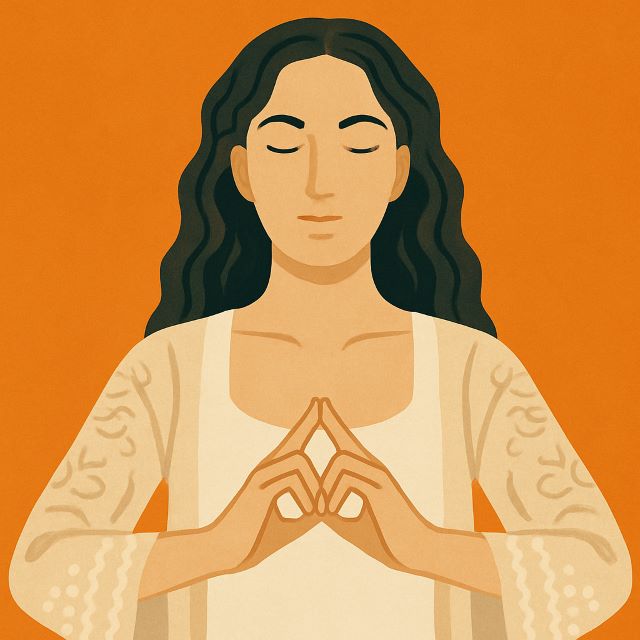You ever get the feeling that life’s gotten way too loud? Too many hacks, too many systems, and way too much advice that leaves you more stressed than before. I get it. Sometimes what actually works isn’t some big secret—it’s something quiet. Still. Almost invisible. That’s what makes mudra meditation so powerful. It’s not about trying harder. It’s about tuning in. A small shift in how you hold your hands… and something inside you begins to settle. Focus sharpens. Energy flows. And suddenly, the noise fades.
What Is Mudra Meditation?
Mudra meditation is simple. You don’t need to do anything dramatic. Just your hands, held with purpose. That’s all it takes sometimes to reset the way you feel. It’s subtle, almost quiet—but it goes deep. What seems simple at first can shift something much bigger inside you.

These hand gestures go way back. Long before apps and routines and biohacks, people were using mudras during prayer, meditation, even healing. In places like India and Tibet, they were passed down through teachers, monks, yogis. Not because it was trendy, but because it worked.
Now, we’re starting to see it again—quietly showing up in new places. You’ll catch it during interviews, press events, even championship games. Hands folded in a certain way. Fingers touching. Stillness in the middle of the chaos. It’s not just coincidence. A lot of high-level performers—CEOs, artists, athletes—use their body to signal focus. And this is one of the ways they do it.
Mudra meditation isn’t complicated. You don’t need a background in yoga. You don’t need to “do it right.” You just need a moment. And your hands.
The Science Behind It: You Are an Electrical Being
You’re wired with more energy than you think. Every part of your body runs on it. Not just your brain, not just your heart—everything. And it’s not just happening inside. That energy moves through you and around you, whether you’re thinking about it or not.
Years ago, a man named Semyon Kirlian created a way to photograph this. What showed up was wild—streams of light, color, movement. It proved something ancient cultures already knew. You’re not just physical. You’re electric.
Now think about your brain. The frontal lobe runs the show. Focus, clarity, choices—this is where it happens. But when your energy’s off? It’s like someone dimmed the lights. Thoughts get fuzzy. You lose steam.
And that’s where mudra meditation comes in.

You use your hands to bring both sides of your brain back into sync. It’s quiet. Subtle. But it works. You’re helping the energy move again. You feel more grounded. Clearer. Lighter.
It’s a reset button—and it’s been in your hands the whole time.
How Mudra Meditation Rewires the Brain
Something happens when you hold your hands in a certain way. It’s hard to explain at first, but you feel it. Your head gets quieter. The noise softens. You start to notice things—like your breath, or the space around you.
That’s not just your imagination.
The brain responds to signals, and your hands send them. With mudra meditation, you’re tapping into that system. You’re waking up parts of the brain that haven’t been fully active. Areas linked to focus, clarity, even your emotions.
Some researchers have looked at this and found changes in the brain’s energy patterns—real shifts, not just “feel-good” stuff. You can think of it like a dimmer switch. Things have been running low, and suddenly, the lights turn up.
It doesn’t take long. A minute. Maybe two. But it’s enough to feel different. More awake. A little more steady. And if you keep doing it, that clarity sticks around longer.
It’s simple. But it works.
The Pyramid Mudra Technique: A Daily Practice
There’s one mudra I keep coming back to. It’s simple—but powerful.
You start by locking your fingers together. Then flip your hands so your index fingers point upward, forming a small triangle. That triangle shape, some say, carries its own frequency. Others say it balances both sides of the brain. All I know is—it works.
Here’s how I use it:
I sit down in a quiet spot. Nothing fancy. Just stillness. I turn on my success hypnosis and let it play softly in the background. Then I form the mudra with my hands and rest them in my lap. My eyes stay open as I look at my vision board—the life I’m creating, printed out in front of me.
One picture at a time, I focus. I feel what it would be like to live that reality. Not just wish for it—feel it. The car, the home, the freedom. I don’t rush. I breathe and stay with the image until something shifts inside—until it feels real.
That’s the key. Mudra meditation isn’t just about hand placement. It’s about locking in the energy while you’re fully present. When you hold that feeling, something starts to settle in your system. You’re not just visualizing—you’re wiring those experiences into your brain. Into your body. Into your field.
Over time, this becomes more than a routine. It becomes a signal. You’re telling your subconscious: this is who I am now. And life begins to match that signal.
Real-Life Manifestation: From Vision Board to Reality
Not long ago, we bought a house. Not just any house—our dream house. It’s out in the open, quiet, with nothing but space and sky around it. The kind of home I used to imagine, but never actually thought I’d walk into one day. Until I did.
The funny part? It was already sitting on my vision board.

We got home from a trip, and my daughter wandered into my office. She stopped in front of the vision board and said, “That’s our house, Daddy.” I leaned in to see what she was pointing at—and there it was. A photo I had put up months earlier. All glass in the back, a pool, open land behind it. It looked just like the house we were standing in.
Right next to it? My car. The one I had always dreamed of. Same model. Same matte black.
Both were images I’d printed out long before either of them became real. I had looked at them every day while sitting in silence, doing my daily mudra meditation. No force. No stress. Just a calm moment, hands locked in that triangle shape, eyes open, and energy focused on what I wanted to feel.
That how I used mudra for manifestation.
The shift didn’t come from pushing harder. It came from getting into alignment—inside first.
When you combine emotion with vision, and you hold it with presence, you’re not just wishing anymore. You’re sending out a signal. Mudra meditation helps lock in that signal. It gives the mind and body a pattern to follow. And once that pattern sets in, life starts filling in the rest.
When and Where to Use Mudra meditation
You don’t need a quiet cave or a perfect meditation setup. That’s the beauty of mudra meditation—you can do it almost anywhere. And you will always feel that meditation enlightenment.
I’ve used it sitting at my desk, between emails. In the car. Even in the middle of a conversation when I needed to ground myself. You just lock your fingers, hold the shape, and breathe. No one even has to notice. It’s that subtle.
Some of the most focused, high-performing people in the world do this. Leaders. Creators. Athletes. You’ll see it if you look closely—fingertips gently pressed together, hands resting in their lap. It’s not just habit. It’s a way to stay present.
Mudra meditation doesn’t ask for much. Just your hands, a little intention, and a moment of quiet—even in the middle of the noise.Final Thoughts: Energy Moves Where You Direct It
You don’t have to fix everything at once. You don’t need the perfect plan or some massive breakthrough. Sometimes all it takes is a small shift—a quiet moment—where you choose to tune back in.
That’s the power of mudra meditation.
It gives you a way to pause and line up with something deeper. It’s not passive. It’s not forceful. It’s a bridge. Between thought and form. Between stillness and momentum. Between who you’ve been—and who you’re becoming.
Try it for a few minutes each day. Just sit, breathe, and let your hands guide the energy where you want it to go. Let it be simple.
And if something starts to shift—if you feel clearer, lighter, more aligned—come back and share it. Someone else might need to hear your story.

